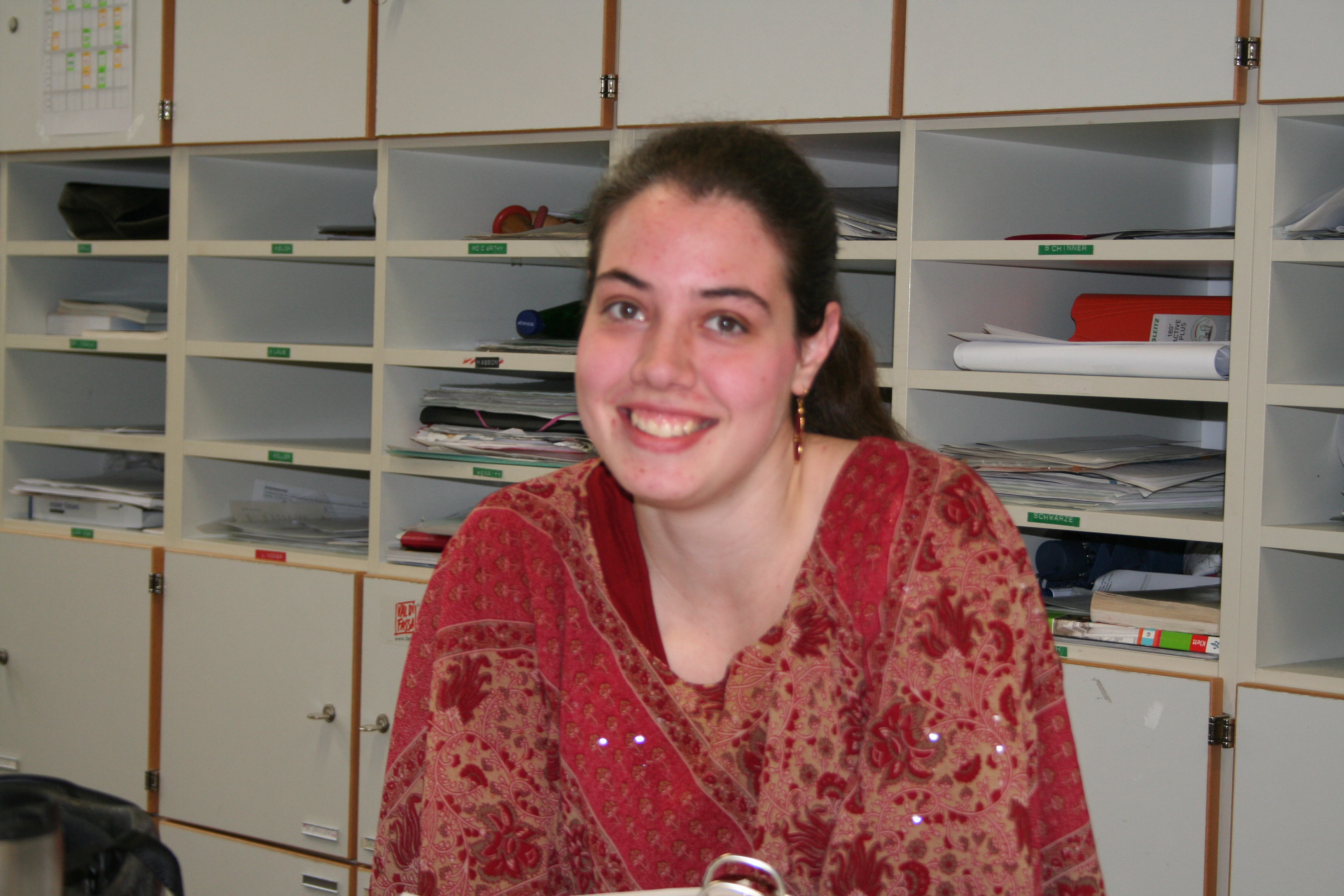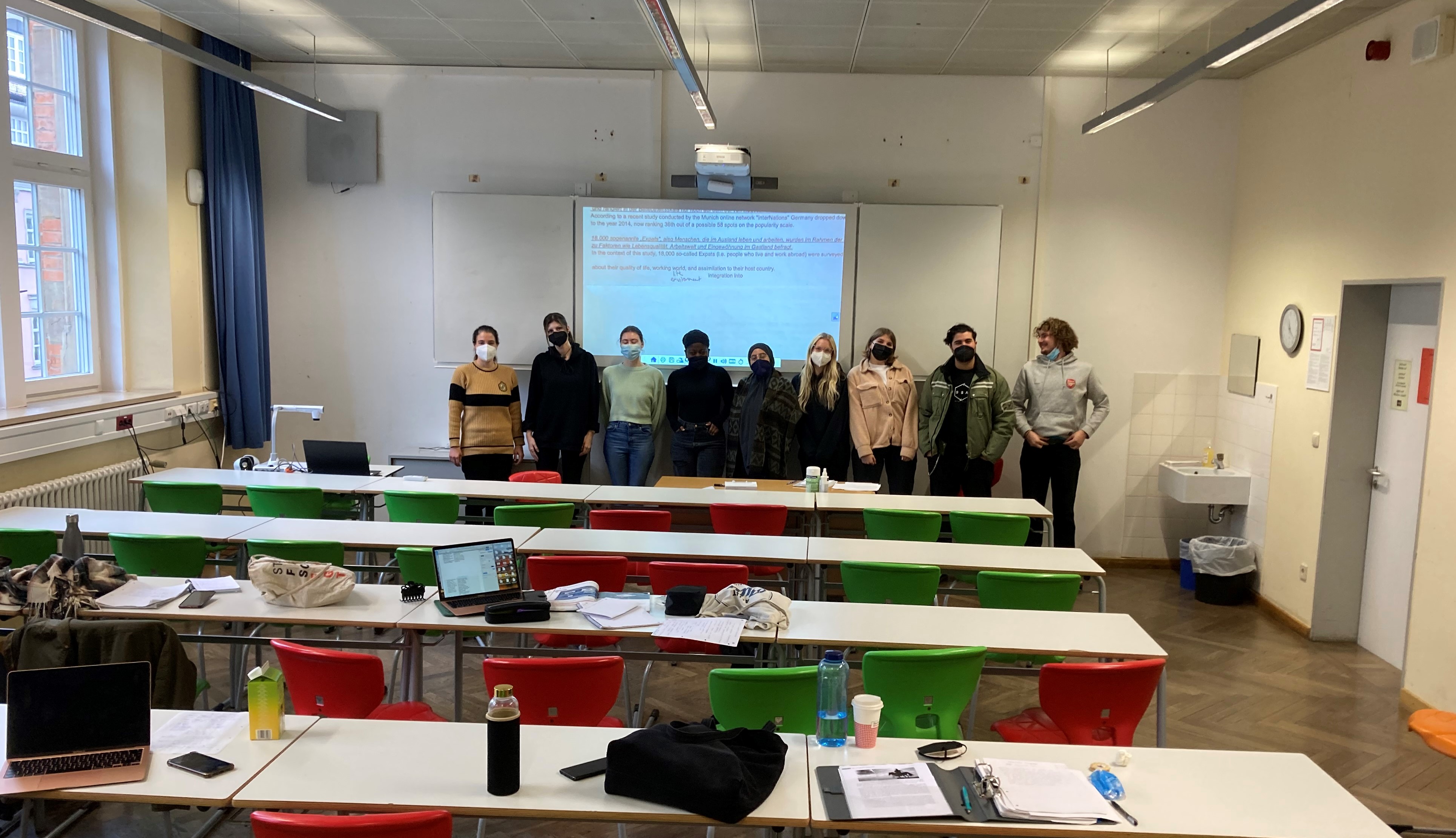JYM alumna: Teaching English in Munich during the lockdown

JYM alumna Renee Remy (2005-06) returned to Munich a month after receiving her M.A. in May 2009 and has been teaching at the Fremdspracheninstitut München (FIM) ever since.
She teaches general and technical English to students preparing them to become Bavarian state-certified translators and interpreters. FIM located in the "Universitätsviertel" just celebrated its 70th anniversary. As German schools and universities were finally catapulted into the digital age during the global COVID-19 pandemic, we checked in with Renee to see how her job and school transitioned during the pandemic and what digitalization has meant for future language training.
FIM is two schools in one. Explain to those more or less familiar with the German school system where your school fits into German higher education.
FIM is a kind of foreign language academy that trains bilingual administrative assistants as well as translators and interpreters. The bilingual administrative assistant school provides an opportunity for students who have graduated from 10th grade (Realschule) to receive training in foreign languages (English, French or Spanish) and economics, to prepare them for office jobs requiring business correspondence expertise in multiple languages. Many students land jobs in patent offices, law firms and foreign companies in Germany and abroad.
The translation and interpreting school is geared towards students who have finished high school (gymnasium) or as additional training for students who have completed the bilingual administrative assistant school. Students specialize in either engineering or economics. They take classes in German and in their foreign language (English, French or Spanish) where they learn engineering/economics-related concepts and terminology in addition to fine-tuning their language skills and gaining cultural knowledge.
After three years of intensive study, students take the Bavarian State certification exam and are then officially allowed to translate technical or economics-related as well as general texts both into and out of their foreign language. Students take classes in both translation and interpreting throughout their studies, but some opt out of the final exam in interpreting. The translation and interpreting certification is now considered a B.A.-Professional in Germany. Students can complete one year of further study at a private language institute in Munich to get a fully recognized B.A. or travel abroad (England/Scotland, France, Spain) to obtain an M.A. in translation or interpreting.
In general, how prepared would you say the Munich school landscape was for distance learning at the outset of the pandemic? FIM relies more heavily on digital technology than other language schools perhaps, was it better prepared for the pandemic?
The Munich school district (as well as most of the districts in Bavaria) was not particularly well prepared for the transition to distance learning. First off, many schools have a significant number of teachers who are on the verge of retirement. Many of these older teachers had trouble learning new programs such as Microsoft Teams and WebEx. These programs took a bit of getting used to, but younger teachers and students adapted quickly. The only issue was that the Munich school district took a very long time to decide which programs should be and/or were allowed to be used for distance learning.
This resulted in us not having Teams accounts until the end of the school year 2020. As we transitioned into hybrid learning (a combo of distance learning and in-person) we very quickly found out that the school's wifi network was not equipped to handle so many devices at the same time. However, the teachers (and students) at FIM are generally very motivated. Most of the teachers also genuinely care about their student's well-being. So, I got the impression that everyone was trying very hard to make distance learning work.
How did your daily routine and interaction with the students change during the height of the pandemic in winter 2020 when classes switched to remote classrooms?

Schools were closed with zero notice in March of 2020. Like I already mentioned, we did not have any online platform to reach students in the beginning. "Class" was conducted via email. We had to send course materials to our students and return personalized feedback for every single student in every single subject.
A full-time course load is 24 classes a week and anywhere between 10-30 students per class, so you can imagine how long it took to give feedback to every single student. Once we got Teams accounts, things became considerably easier. It was quite convenient to be able to just roll out of bed and teach a class. However, staring into a computer screen for hours on end gave me a headache every single day. In theory, I had more free time due to not having to commute to and from school. But, I did not sleep very well and had significantly more prep work than before the pandemic.
As far as interaction with students is concerned, it was a bit of a mixed bag. Some students liked the online format, still participated in discussions and asked questions. I also got the impression that some students performed better in an online class since there wasn't anyone sitting directly next to them to serve as a distraction. Students liked being able to share their screens and having the opportunity to post documents in the chat. It made class easier to follow. However, some students suffered from a lack of personal interaction. We had already had a growing number of students who suffer from depression and other psychological disorders and online classes did not do those people any favors.
There was significant discussion between teachers and students about whether or not students should be required to turn their cameras on during class. The consensus was that students were not required to turn their cameras on. For this reason, one of the most difficult parts of online class was not being able to read students' facial expressions. I rely on facial expressions to determine whether or not students are following the discussion and understanding the material. Some students do not feel comfortable asking questions online and the discussion moves much faster as a result. In the end, we got through more material, but students did not necessarily retain as much.
Have there been positive outcomes in your field in general and your job in specific as a result of modernizing?
It is much easier to attend professional development seminars and conferences being held in far-away places when they are held online. The number of online course offerings has also drastically increased. Sometimes it is easier to reduce the amount of tension and nervousness among students in an online environment. Students can ask questions during class in a private chat with the teacher or in a private chat with other students without disrupting class. This often reduces pressure, making weaker students feel less embarrassed about not understanding. Stronger students can ask difficult questions without running the risk of confusing and/or annoying other students in class. Another positive aspect is we are now sending students onto the job market with a new set of skills. They can interact in a professional online environment in a way that previous generations could not.
You have also embarked in a new direction learning Finnish as part of the cooperation with a school in Finland (which one?). Tell us about this.
I have been in charge of the Erasmus-sponsored student exchange with Business College Helsinki for the past 10 years, although the program has existed for much longer. Every spring I accompany a group of students to Helsinki, where they participate in an international seminar on a business-related topic. They have the opportunity to interact with students from the Business College and students from other countries. Finnish students from the Business College visit FIM every year in December. Many of my students have very little prior knowledge about the Nordic countries before the trip and Finland is not usually high up on their bucket list of places to visit. I have to admit that I was in the same boat when I took over the program. Meanwhile, I have become very interested in the Finnish language and culture.
Although I could very easily get by with English (and on some occasions even German) in Finland, I started feeling guilty about my lack of Finnish skills after many trips to Helsinki. After several attempts at self-study failed, I finally signed up for my first Finnish class. I've now been taking Finnish classes for three years both in Munich and in various cities in Finland (online and in-person) and have reached the upper-intermediate (B2) level. The Finnish language is very complex, but it is not as complicated as one might think when you are fluent in English and German.
There are many similarities as far as grammar and vocabulary (compound words) are concerned. Communicating with the Finns in Finnish has allowed me to form lasting friendships that would not have been possible had I not started learning the language. Erasmus+ pays for our travel to Finland and for the majority of my Finnish classes. The pandemic has put a bit of a damper on international travel. But, we are hopeful that we will be able to travel to Helsinki again in March. This year's seminar topic is diversity and inclusion in the workplace.